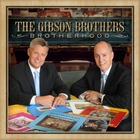Liner Notes street date: 02/24/2015
ARTIST: Gibson Brothers
TITLE: Brotherhood
LABEL: Rounder
UPC: 888072359864
11661-35986-02
For thousands of years, sailors navigated by the stars. The same celestial bodies that led these ships away from home were the same ones that brought them back. Since childhood, Eric and Leigh Gibson’s guiding stars have been brother duos; more than 20 years after they first set off on their journey as professional bluegrass musicians, they’ve returned to the music that first steered them.
It did, however, take several years for Leigh to get his big brother to agree to this project – Eric was adamant that they not record an entire album of what he called “maudlin parlor tunes.” (Maudlin Parlor Tunes, by the way, would become the wry working title of this album before the band decided on Brotherhood.)
But from the beginning, this album was so much more than that. Its fifteen songs span nearly a century of music history from “The Eastbound Train,” which has roots that can be traced to the 1896 broadside “Going for a Pardon,” to Tompall and the Glaser Brothers’ “It’ll Be Her,” which topped out at No. 19 on the Billboard Hot Country Singles chart in 1982. The latter song comes from Lovin’ Her Was Easier, an LP that was in heavy rotation at the Gibson family’s dairy farm in Ellenburg Depot, an upstate New York town that’s closer to the Canadian border than the nearest record store. “Recording that song took me back to our living room, when I was just 12 years old and learning how to play banjo,” remembers Eric.
Bluegrass and country fans will recognize several familiar songs on Brotherhood, including “I Have Found the Way,” which Bill and Charlie Monroe recorded in 1937, the Louvin Brothers’ “Seven Year Blues,” and “Sweet Little Miss Blue Eyes,” which Eric and Leigh first heard from Jim and Jesse McReynolds, the first brother duo to capture Leigh and Eric’s attention as budding musicians. For their version of Bobby and Sonny Osborne’s 1960 recording, “Each Season Changes You,” the Gibsons tapped Ronnie Reno, who spent five years as a member of The Osborne Brothers’ band, to sing on this song as well as another favorite from the bluegrass canon, “How Mountain Girls Can Love.”
The album also includes songs from some lesser-known acts, including “What a Wonderful Savior is He,” which The Four Brothers Quartet, made up of two Knoxville-area duos, the Brewster Brothers and Webster Brothers, recorded in 1959. Eric and Leigh decided to make their own brotherly foursome, selecting Ronnie and Rob McCoury to sing baritone and bass, respectively. There’s a revved-up cover of “I’m Troubled,” which was recorded by The Lilly Brothers and Blue Sky Boys, and a stunning version of “The Sweetest Gift,” a James B. Coats song that The Blue Sky Boys – Bill and Earl Bolick – cut in 1949 (the Bailey Brothers released their own take on the song two years earlier).
Bookending Brotherhood is a pair of Everly Brothers songs; the Gibsons begin with a boyish cover of “Bye Bye Love” and end with a cover of “Crying in the Rain,” where Russ Pahl’s aching pedal steel almost feels like a third vocalist. (Phil and Don also recorded a version of “Long Time Gone,” written by Leslie York, one half of country duo The York Brothers, for Songs Our Daddy Taught Us in 1958.)
Though the material is familiar, in many ways, Brotherhood is an album of firsts. It’s the Gibsons’ first covers album, their first release with Rounder Records, and the first recording featuring the band’s newest member, extraordinary mandolin player and harmony singer Jesse Brock, joining longtime members Clayton Campbell, the fiddler who recently marked his tenth year with the band, and bassist Mike Barber, who’s been with Eric and Leigh for so long that they call him the third Gibson Brother. What’s more, there’s a sense of poise on Brotherhood that isn’t on the Brothers’ previous records. The Gibsons have found themselves as artists. “In the past five years, we’ve truly become The Gibson Brothers rather than trying to measure up to somebody else’s ideas about brother acts,” explains Leigh. “That confidence has played a big role in our evolution as musicians.”
Much of the Gibson Brothers’ artistic growth can be attributed to their desire to keep learning about the music they love. They used Brotherhood as an opportunity to expand their own knowledge of brother acts, seeking out country music aficionados and tracking down recordings made by new-to-them groups like North Carolina trio The Church Brothers (whose “Angel with Blue Eyes” has flown under the radar for more than half a century) and the aforementioned Yorks, Websters and Brewsters.
Blessed with talent, modesty, and an exceptional work ethic that’s kept them going for more than two decades, the Gibson Brothers are the Lou Gehrigs of bluegrass. (Leigh and Eric are also devout Yankees fans. It is perhaps their only flaw.) Unlike several of the brother duos they cover on this album, these guys actually like each other, and it’s truly been a gift to watch their careers blossom over the last several years. This album represents a new era for the band. Not only is it the strongest record of their career, it honors the Gibsons’ influences, which are rooted in classic country and bluegrass, while establishing them as a vital roots music act with a future as bright as those guiding stars that keep sailors on course.
Eric and Leigh’s musical journey has taken them from a farmhouse living room to center stage at the Ryman Auditorium. With Brotherhood, they’ve found their way home.
Juli Thanki
October 2014
